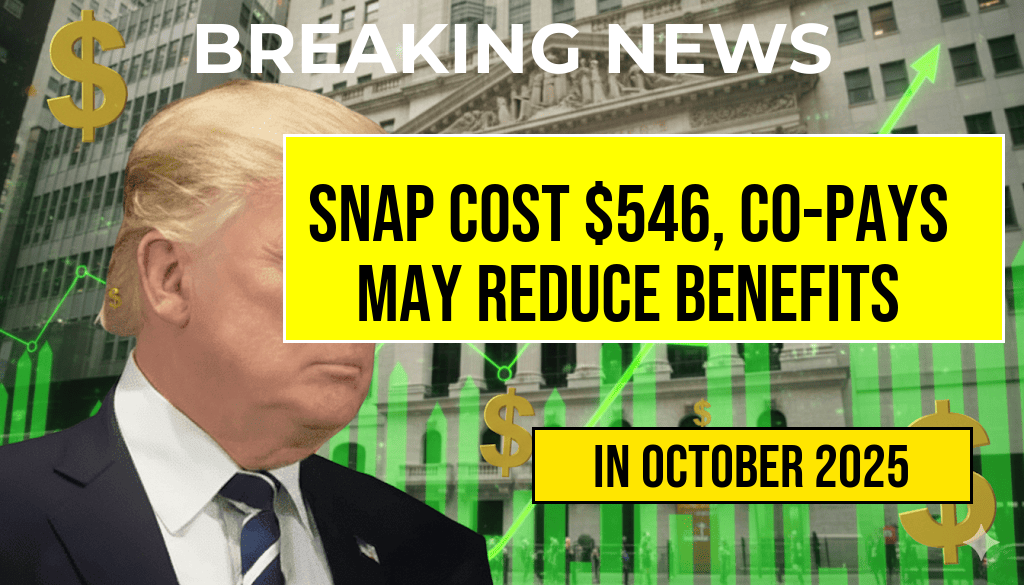SNAP Benefits for Two Individuals Cost $546, but Switching to State Co-Pay Plans Could Reduce Benefits by Over $50
For many families relying on the Supplemental Nutrition Assistance Program (SNAP), understanding the true costs and potential savings can be complex. Recent data indicates that providing SNAP benefits for a household of two costs approximately $546 per month at the federal level. However, some states have introduced alternative co-pay plans that, while aimed at reducing administrative burdens, may unintentionally cut benefits by more than $50 for recipients. These shifts raise questions about the balance between program efficiency and adequate support for vulnerable populations.
Understanding SNAP and Its Cost Structure
The SNAP program, administered federally but managed at the state level, offers monthly benefits designed to help low-income individuals and families purchase food. The average benefit for a household of two hovers around $546, based on 2023 data from the U.S. Department of Agriculture (USDA FNS). This figure considers income levels, household size, and other eligibility criteria, ensuring that assistance reflects actual needs.
Despite the federal baseline, some states have introduced co-pay plans or alternative structures intended to streamline administrative costs or promote personal responsibility. These plans often involve recipients paying a small portion of their benefits out-of-pocket or participating in work programs, which can impact overall benefit levels.
State Co-Pay Plans: A Closer Look
Several states have adopted co-pay or premium-like structures for SNAP recipients. While the intent is to encourage employment or reduce program fraud, these measures can effectively reduce the total benefits received. For example, a recent analysis found that in certain jurisdictions, a household of two could see a reduction exceeding $50 per month, translating to less food security for vulnerable families.
| Scenario | Monthly Benefit | Deduction or Co-Pay | Net Benefit | Potential Reduction |
|---|---|---|---|---|
| Federal SNAP benefit (baseline) | $546 | N/A | $546 | 0 |
| State co-pay plan (example) | $546 | $50 | $496 | >$50 |
This table highlights how co-pay plans, while seemingly minimal, can significantly cut into household food budgets. For families already operating on tight margins, a $50 reduction can mean the difference between sufficient nutrition and food insecurity.
Policy Implications and Community Impact
Advocates argue that co-pay plans promote responsibility and reduce waste, but critics warn they risk undermining the fundamental purpose of SNAP: providing reliable nutrition assistance. Studies from organizations like the Center on Budget and Policy Priorities suggest that even modest reductions in benefits can lead to increased reliance on food pantries, housing assistance, or emergency services.
Moreover, the disparities between federal standards and state implementations create a patchwork of support, with some families facing deeper cuts depending on their location. States with higher living costs or larger low-income populations may see more aggressive co-pay policies, further exacerbating food insecurity in vulnerable communities.
What Recipients Should Know
- Review your state’s policies: Eligibility rules and co-pay requirements vary widely. Check with local SNAP offices or official websites for updates.
- Calculate potential impacts: Understand how co-pay plans may reduce your benefits and plan accordingly.
- Explore additional assistance options: Programs like WIC, local food banks, or community-supported agriculture can supplement SNAP benefits.
Looking Ahead
As federal and state policymakers evaluate the future of SNAP, balancing program sustainability with adequate support remains a contentious issue. Recent legislative proposals aim to tighten eligibility criteria and introduce co-pay requirements, but advocates emphasize the importance of protecting vulnerable populations from benefit erosion.
For families navigating these changes, staying informed is crucial. Resources such as the USDA SNAP website and local social service agencies provide guidance and support to ensure access to food assistance remains stable amidst shifting policy landscapes.
Frequently Asked Questions
Question
What is the cost of SNAP for Two, and how does it compare to state co-pay plans?
Answer
The SNAP for Two program costs $546, which is the standard rate for eligible couples. In comparison, state co-pay plans can potentially reduce your benefits by over $50, impacting your overall assistance.
Question
How might choosing a state co-pay plan affect my SNAP benefits?
Answer
Opting for a state co-pay plan could reduce your benefits by more than $50, potentially decreasing your overall assistance and making it more challenging to meet your household needs.
Question
Who is eligible for the SNAP for Two program?
Answer
The SNAP for Two program is designed for couples or households of two who meet specific income and eligibility criteria defined by state and federal guidelines.
Question
Can participating in state co-pay plans be more cost-effective than SNAP for Two?
Answer
Yes, state co-pay plans may offer a more affordable option by potentially reducing your benefits by over $50, which could result in overall savings depending on your household circumstances.
Question
Where can I find more information about SNAP for Two and state co-pay plans?
Answer
You can visit your state social services website or contact your local SNAP office for detailed information about benefit options, eligibility, and how different plans may impact your assistance.

Leave a Reply